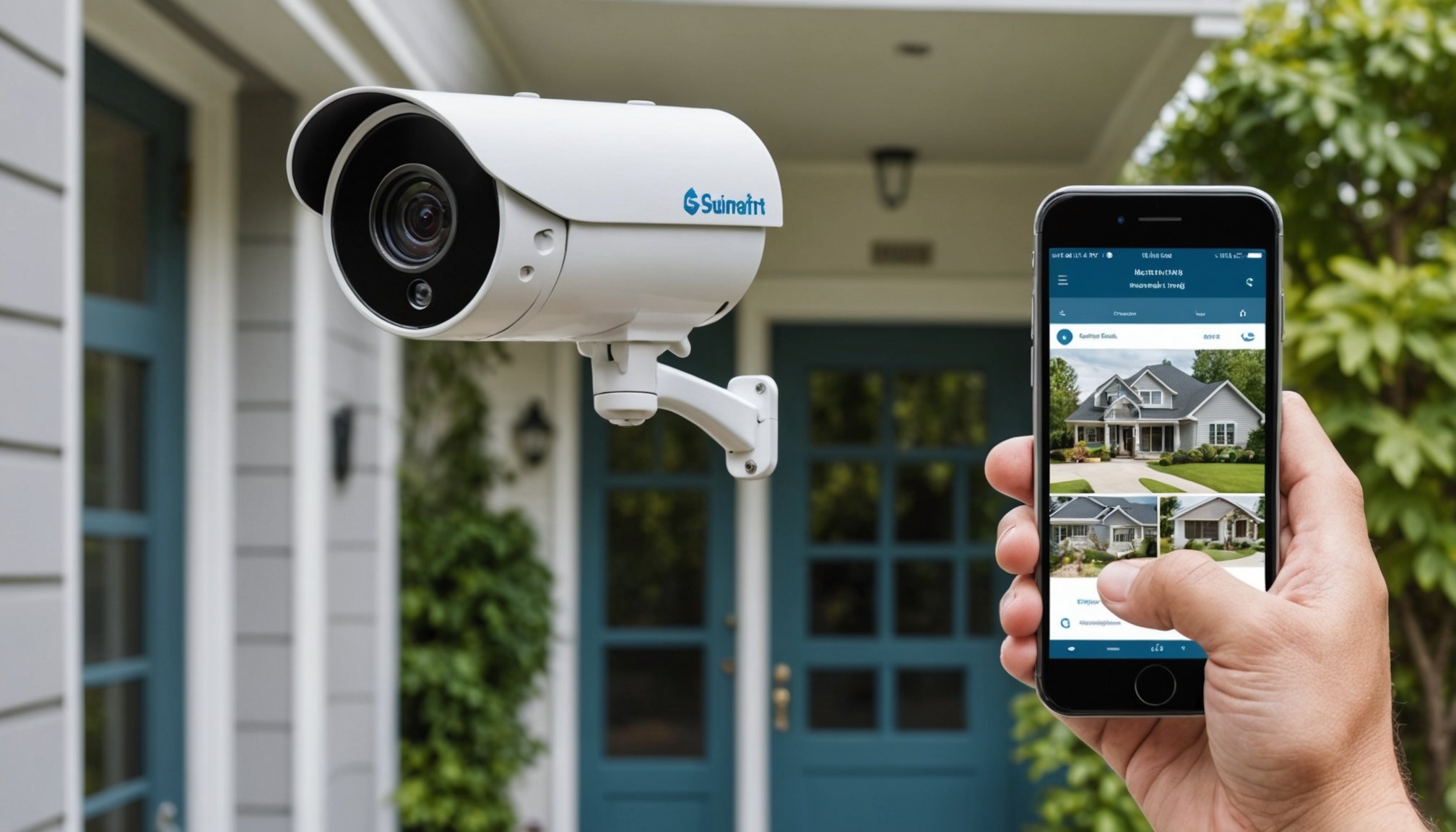Transform Your Home Security: A Comprehensive Smartphone Guide to Installing a Smart Surveillance System
In today’s world, ensuring the security of your home is more crucial than ever. With the advancement of smart technology, installing a smart surveillance system has become a viable and effective way to protect your property and gain peace of mind. Here’s a step-by-step guide on how to transform your home security using your smartphone.
Choosing the Right Smart Security System
When it comes to selecting a smart security system, there are several factors to consider. Here are a few key points to help you make the best decision for your home:
In parallel : Elevate your home security: harnessing your smartphone for effective smoke alarm monitoring and control
Types of Security Systems
- Wireless Systems: These are highly recommended for their ease of installation and flexibility. Systems like the TerraHome 4G & WiFi do not require any heavy installation work and offer continuous surveillance even in the event of an internet outage[1].
- Wired Systems: While more traditional, these systems can be more reliable in terms of signal strength but may require more effort to install.
Key Features to Look For
- Motion Detection: A crucial feature that alerts you to any suspicious movement around your home.
- Video Surveillance: Live video feed and recording capabilities to monitor your home in real-time.
- Smart Integration: Compatibility with smart home devices and assistants like Google Assistant or Amazon Alexa.
- Cloud Storage: Secure storage for your video recordings, ensuring you can access them even if the device is compromised.
Installing Your Smart Security Cameras
Installing smart security cameras is a relatively straightforward process, especially with the right guidance.
Preparing the Necessary Equipment
Before you start, ensure you have all the necessary equipment:
Also read : Unlock ultimate energy savings: a guide to linking your smartphone with a smart thermostat
- Cameras: Choose cameras that fit your needs, such as indoor, outdoor, or a combination of both.
- Power Source: Batteries or power adapters, depending on the camera model.
- Network Connectivity: Ensure your Wi-Fi network is stable and robust to support your cameras[3].
Step-by-Step Installation Guide
Here’s a detailed guide to help you through the installation process:
Assembling and Powering the Camera
- Carefully unbox and assemble the camera components, including the camera body, lens, battery, charger, and memory card if applicable[2].
Connecting to Your Network
- Download the manufacturer’s app on your smartphone (e.g., Smart Life Tuya for TerraHome or the Eufy app for Eufy cameras).
- Follow the app instructions to connect your camera to your Wi-Fi network. Some cameras may require scanning a QR code or entering the device’s serial number[1][2].
Configuring Camera Settings
- Once connected, personalize your camera settings through the app. This includes setting up alert zones, adjusting sensor sensitivity to avoid false alerts, and scheduling recording times[1].
Securing Your Camera
- Ensure your camera is placed in a secure location, such as at a height to prevent tampering, and in strategic areas like entry points and exterior zones[3].
Connecting Your Security System to Your Smartphone
Connecting your security system to your smartphone is the key to real-time monitoring and alerts.
Downloading and Installing the App
- Download the app associated with your security system from the App Store or Google Play. For example, the TerraHome app allows you to configure your device, receive real-time notifications, and manage all security settings directly from your phone[1].
Setting Up Notifications and Alerts
- Configure the app to send you instant notifications in case of motion detection or other security breaches. You can also set up alerts for specific times or events, such as when someone enters or leaves your home[1].
Accessing Live Video Feed
- Use your app to access the live video feed from your cameras. This feature is particularly useful for monitoring your home remotely, ensuring you can see what’s happening in real-time[2].
Personalizing Your Security System
Personalizing your security system to your specific needs is crucial for effective home security.
Customizing Alert Zones
- Designate specific areas of your home as priority zones for monitoring. This could include entry points, living areas, or areas with valuable items[1].
Adjusting Sensor Sensitivity
- Adjust the sensitivity of your motion sensors to avoid false alerts. This ensures you receive notifications only when necessary, reducing unnecessary alarms[1].
Scheduling Security
- Program your security system to activate and deactivate at specific times. This can be particularly useful if you have a regular schedule or if you want to ensure your home is secure when you’re away[1].
Why Choose a Smart Security System Without Subscription?
Opting for a smart security system without a subscription can be highly beneficial.
Cost-Effective
- Systems like TerraHome offer a one-time investment with no recurring fees, allowing you to control your budget while maintaining high-level security[1].
Flexibility
- Without the need for subscriptions, you have more flexibility in managing your security system. You can store video recordings locally or use cloud storage options that fit your needs[4].
Comparing Top Smart Security Cameras
Here’s a comparison of some top smart security cameras to help you make an informed decision:
| Camera Model | Key Features | Price Range | Subscription Required |
|---|---|---|---|
| TerraHome 4G & WiFi | Motion detection, live video feed, no subscription | $200-$300 | No |
| Eufy Panorama Camera | 360-degree view, motion detection, QR code setup | $150-$250 | No |
| Arlo Pro 5 | Wireless, 4K video, night vision, facial recognition | $300-$400 | Optional |
| Netatmo Outdoor Camera | Weather-resistant, night vision, motion detection | $200-$300 | No |
| TP-Link Tapo C420 | 2K resolution, motion detection, cloud storage | $200-$300 | Optional |
Practical Tips and Considerations
Here are some practical tips to keep in mind when setting up your smart security system:
Placement of Cameras
- Place cameras at strategic points such as entry doors, windows, and exterior areas to maximize coverage[3].
Power Management
- Ensure your cameras are powered securely. Use programmable outlets or voltage converters to prevent power surges that could damage your devices[3].
DIY vs Professional Installation
- While many smart security systems are designed for DIY installation, if you’re not comfortable with the process, consider hiring a professional to ensure everything is set up correctly.
Integrating with Other Smart Home Devices
- Integrate your security system with other smart home devices like smart locks and thermostats for a seamless smart home experience.
Transforming your home security with a smart surveillance system is a smart and effective way to protect your property and gain peace of mind. By following these steps and considering the key features and tips outlined above, you can ensure your home is secure and monitored at all times.
As a homeowner, investing in a smart security system is one of the best decisions you can make. With the ability to monitor your home in real-time, receive instant notifications, and customize your security settings, you can rest assured that your home and loved ones are safe.
So, whether you’re looking to enhance your existing security measures or starting from scratch, a smart surveillance system is the way to go. With the right tools and a little bit of setup, you can enjoy the benefits of a secure and connected home. Happy installing
Troubleshooting Common Issues
When dealing with system errors during the setup or operation of your device, it’s essential to tackle the most frequent concerns head-on. Connectivity issues often top the list. Ensure that your device is connected to a stable Wi-Fi network. If problems persist, reconnect by restarting your router or checking network settings. This simple step can resolve many connectivity-related issues.
Camera performance can also become a concern for users. If images are unclear or if the camera fails to operate, first ensure the lens is clean and unobstructed. Adjusting camera settings can also be helpful in resolving image quality problems. For significant deviations in expected performance, consulting the device’s manual or online technical support forums can provide tailored troubleshooting tips.
However, not all issues can or should be handled by the user. It’s crucial to recognise when professional help is necessary. Persistent system errors or hardware malfunctions often require professional assessment. Engaging with technical support or visiting a service center ensures the device receives appropriate care, preventing potential escalations of issues and preserving device functionality.






